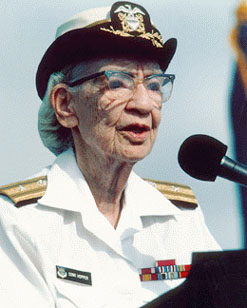| Grace Murray Hopper  AKA Grace Brewster Murray AKA Grace Brewster Murray
Born: 9-Dec-1906
Birthplace: New York City
Died: 1-Jan-1992
Location of death: Arlington, VA
Cause of death: Natural Causes
Remains: Buried, Arlington National Cemetery, Arlington, VA
Gender: Female
Race or Ethnicity: White
Sexual orientation: Straight
Occupation: Computer Programmer, Inventor, Mathematician Nationality: United States
Executive summary: Computer programming pioneer Military service: US Navy (to Rear Admiral, 1943-86) Computer pioneer and mathematician Grace Murray Hopper is best known for her 1952 invention of Flow-Matic, the first compiler — software that translates instructions written in English into machine language for the target computer. Compilers have allowed the development of computers that seem to "understand" English, a breakthrough which lets computers be programmed by people who might lack an advanced degree in mathematics.
Hopper worked on several first-generation computers, including the Mark I, Mark II, and Mark III. She helped John Presper Eckert and John William Mauchly with the design and development of the BINAC (Binary Automatic Computer), and she was involved with programming the UNIVAC I, the first U.S. commercial electronic computer. In 1959 she wrote the original specifications for the COBOL (COmmon Business-Oriented Language) programming language, which formed the basis of software design for the next generation of computers. She was the first winner of the Data Processing Management Association's Man of the Year Award, in 1969.
As a girl she disassembled and reassembled the alarm clocks in her family's home, and as a young woman she studied under Řystein Ore at Yale. She joined the Navy WAVES (Women Accepted for Voluntary Emergency Service) in 1943, and was assigned to work under Howard Aiken at Harvard's Bureau of Ordnance Computation Project, where she became an expert at the heavy mathematics then required for programming, and literally wrote the operating manual. Her first major innovation was to catalog and share common portions of different programs, to avoid "reinventing the wheel" with every piece of software. She frequently encouraged co-workers and subordinates to think beyond the bounds of the ordinary, and to illustrate the point she kept a clock in her office that ran counter-clockwise.
According to a tale often told by Hopper, the term "computer bug" was inspired by a 1947 incident at the Harvard lab, where bugs — meaning, insects — had been suspected as the cause of a recurring malfunction. A technician found and killed a moth at relay #70, panel F, deep inside the room-sized Mark I computer, and Hopper taped the dead bug to the lab's log, with the notation, "First actual case of bug being found."
She retired from the US Navy three times — first in 1946, switching to the Naval Reserve; then in 1966 with the rank of Commander, but within a year Navy brass asked her to return, to help develop an automated payroll system. She was promoted to captain in 1973, and retired for the third time in 1986 with the rank of rear admiral. She died in 1992, and was buried with military honors at Arlington National Cemetery. She is the namesake of the Navy destroyer USS Hopper, and the Hopper Award, presented annually by the Association for Computing Machinery.
Her brother, Roger F. Murray, was an economist who devised and proposed the concept of the individual retirement account. Father: Walter Murray (insurance broker, b. 20-May-1873, d. 13-Oct-1947)
Mother: Mary Campbell Van Horne (b. 24-Jun-1883, m. 21-May-1903)
Sister: Marry Murray Westcote (statistician, b. circa 1909)
Brother: Roger Franklin Murray (economist, b. 11-Oct-1911, d. 13-Apr-1998)
Husband: Vincent Foster Hopper (author-teacher, b. 1906, m. 1930, div. 1945, d. 1976, no children)
University: Hartridge School, Plainfield, NJ (1923)
University: BA Mathematics, Vassar College (1928)
University: MA Mathematics and Physics, Yale University (1930)
University: PhD Mathematics, Yale University (1934)
Teacher: Mathematics, Vassar College (1931-37)
Teacher: Ass't Prof. of Mathematics, Vassar College (1937-39)
Teacher: Assoc. Prof. of Mathematics, Vassar College (1939-41)
Scholar: New York University (1941-42)
Teacher: Ass't Prof. of Mathematics, Barnard College (1942-43)
Fellow: Engineering Sciences and Applied Physics, Harvard University (1946-49)
Lecturer: Engineering Sciences, University of Pennsylvania (1959-60)
Lecturer: Management Sciences, George Washington University (1971-78)
Digital Equipment Corporation Sr. Consultant (1986-92)
Sperry Rand Staff Scientist, Sperry Univac (1964-71)
Sperry Rand Systems Engineer, Sperry Univac (1952-64)
Sperry Rand Sr. Scientist, Eckert-Mauchly (1949-52)
Naval Ordnance Development Award 1946
Society of Women Engineers Achievement Award 1964
DPMA Computer Sciences Man of the Year 1969
ACM Harry Goode Memorial Award 1970
Legion of Merit 1973
ACM Distinguished Member Award 1976
IEEE W. Wallace McDowell Award 1976
Meritorious Service Medal 1980
ACM Distinguished Service Award 1983
IEEE Computer Pioneer Medal 1983
Navy Distinguished Service Medal 1986
IEEE Distinguished Service Award 1988
National Medal of Technology and Innovation 1990
American Association for the Advancement of Science 1963
Association for Computing Machinery
British Computer Society Foreign Member, 1973
Data Processing Management Association
IEEE 1962
National Academy of Engineering 1973
Navy Relief Society
Phi Beta Kappa Society
Sigma Xi Scientific Research Society 1934
Risk Factors: Smoking
Author of books:
A Manual of Operations for the Automatic Sequence Controlled Calculator (1946)
Understanding Computers (1984, textbook; with Steven L. Mandell)
Requires Flash 7+ and Javascript.
Do you know something we don't?
Submit a correction or make a comment about this profile
Copyright ©2019 Soylent Communications
|